
Tabebuia is a genus of flowering plants in the family Bignoniaceae. The common name "roble" is sometimes found in English. Tabebuias have been called "trumpet trees", but this name is usually applied to other trees and has become a source of confusion and misidentification.

Genipa is a genus of trees in the family Rubiaceae. This genus is native to the American tropical forests.

Acanthaceae is a family of dicotyledonous flowering plants containing almost 250 genera and about 2500 species. Most are tropical herbs, shrubs, or twining vines; some are epiphytes. Only a few species are distributed in temperate regions. The four main centres of distribution are Indonesia and Malaysia, Africa, Brazil, and Central America. Representatives of the family can be found in nearly every habitat, including dense or open forests, scrublands, wet fields and valleys, sea coast and marine areas, swamps, and mangrove forests.

Bignoniaceae is a family of flowering plants in the order Lamiales commonly known as the bignonias or trumpet vines. It is not known to which of the other families in the order it is most closely related.
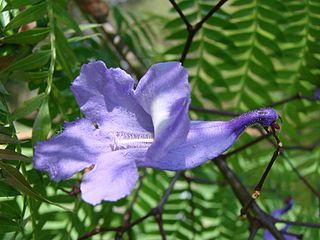
Jacaranda is a genus of 49 species of flowering plants in the family Bignoniaceae, native to tropical and subtropical regions of the Americas. The generic name is also used as the common name.
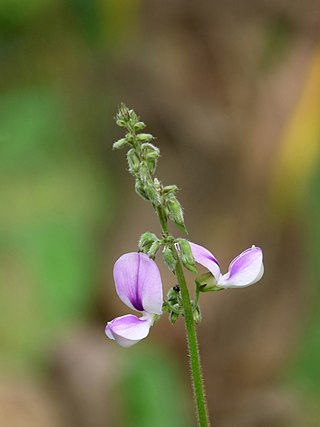
Pueraria is a genus of 15–20 species of legumes native to Asia. The best known member is kudzu, also called Japanese arrowroot. The genus is named after 19th century Swiss botanist Marc Nicolas Puerari.
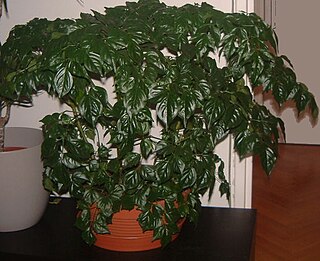
Radermachera is a genus of about 17 species of flowering plants in the family Bignoniaceae, native to southeastern Asia. They are evergreen trees reaching 5–40 m tall, with bipinnate or tripinnate leaves, and panicles of large bell-shaped, white, pink, pale purple or yellow flowers 5–7 cm diameter.

Bignonia is a genus of flowering plants in the family Bignoniaceae. Its genus and family were named after Jean-Paul Bignon by his protégé Joseph Pitton de Tournefort in 1694, and the genus was established as part of modern botanical nomenclature in 1753 by Carl Linnaeus. Species have been recorded from the southern USA, Central to most of South America.

Stereospermum is a genus of trees in the paleotropical clade of the family Bignoniaceae. A species of Stereospermum is used in herbal medicine in Ayurveda as well as it is an integral part of the culture and tradition of the cold desert biosphere reserve.
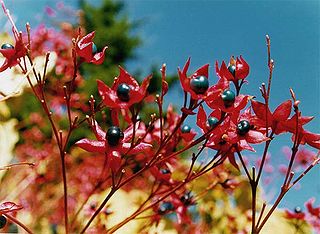
Clerodendrum is a genus of flowering plants formerly placed in the family Verbenaceae, but now considered to belong to the Lamiaceae (mint) family. Its common names include glorybower, bagflower and bleeding-heart. It is currently classified in the subfamily Ajugoideae, being one of several genera transferred from Verbenaceae to Lamiaceae in the 1990s, based on phylogenetic analysis of morphological and molecular data.
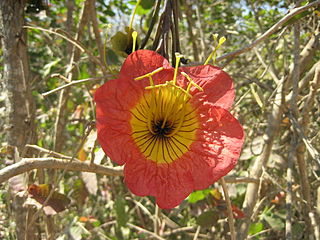
Fernandoa is a genus of plants in the family Bignoniaceae.

Memecylon is a plant group in Melastomataceae. It consists of 350-400 species of small to medium-sized trees and shrubs occurring in the Old World tropics. Memecylon is a monophyletic group basal to the Melastomataceae clade. Memecylon taxa have more than 600 published basionyms. Diversity of this group is concentrated in tropical Africa, Madagascar, Sri Lanka, India and Malaysia.
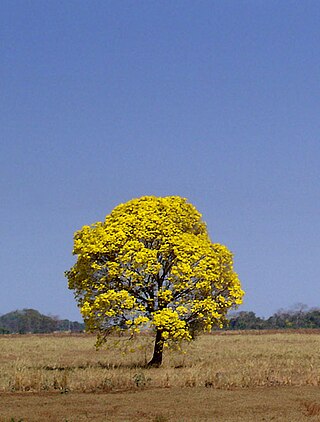
Handroanthus is a genus of flowering plants in the family Bignoniaceae. It consists of 30 species of trees, known in Latin America by the common names poui, pau d'arco, or ipê. The latter sometimes appears as epay or simply ipe (unaccented) in English. The large timber species are sometimes called lapacho or guayacan, but these names are more properly applied to the species Handroanthus lapacho and Handroanthus guayacan, respectively.
Ekmanianthe is a genus of flowering plants in the family Bignoniaceae. It is most closely related to Tabebuia and has sometimes been included within it. It consists of two species of trees, neither of which is especially common in any part of its range:

Astianthus is a monotypic genus of flowering plants in the Bignoniaceae family. The sole species is Astianthus viminalis. It is known by the common names achuchil in Mexico and chilca in Guatemala and Honduras.

Amphilophium is a genus of flowering plants in the family Bignoniaceae, native to South America. Amphilophium crucigerum has escaped from cultivation elsewhere, and has become an invasive weed in Australia.

Dolichandra is a genus of flowering plants in the family Bignoniaceae, native to Latin America and the Caribbean. They are climbing lianas with trifid and uncate tendrils. The best-known species is Dolichandra unguis-cati.
Xylophragma is a genus of flowering plants in the family Bignoniaceae, native to dry forests of Mexico, Central America, Trinidad and northern South America. They are lianas or scandent shrubs.
Haplophragma sulfureum is a tree in the Bignoniaceae family, found in four countries of Southeast Asia. The pods are used as tinder, while the wood is used for light construction and traditional medicine.
Martinella is a genus of flowering plants belonging to the family Bignoniaceae. It is a genus of Neotropical lianas within the tribe Bignonieae.

















